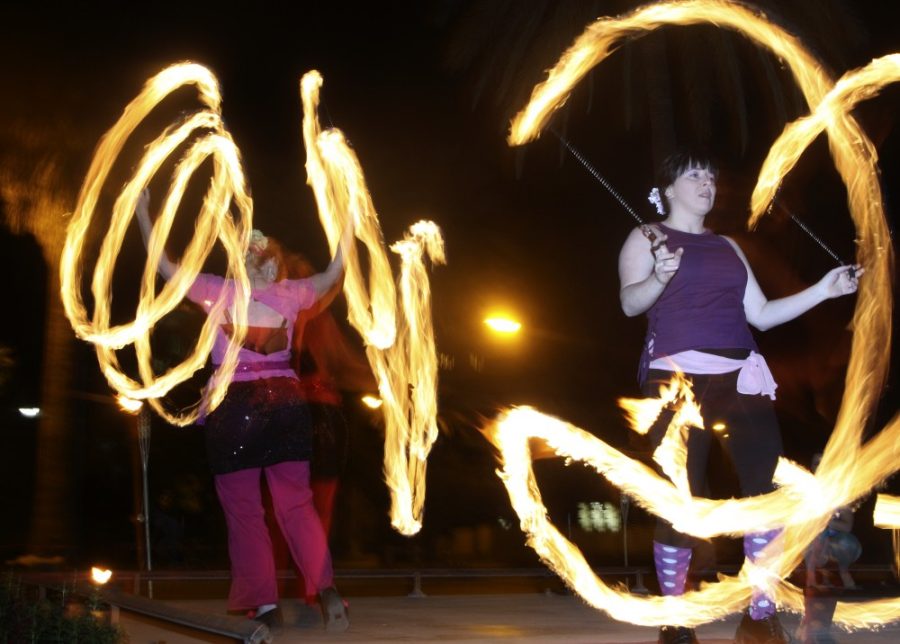Any dance class can help you scratch the surface of the art. But a class in poi spinning with Elemental Artistry may spark your interest more than you anticipated.
Fire dancing has been a dangerous form of performance art used in ritual settings throughout the world for centuries, executed with deft skill by turning, spinning and flipping flaming torches, batons and hoops. It originated in New Zealand tribes. In some tribes, women used it to both ease their children to sleep and also strengthen their wrists for household work. In other tribes, men used harder, denser and heavier wooden poi balls to spin for warrior training and would hit themselves on purpose to demonstrate strength.
Elemental Artistry performance troupe has been bringing this art to SkyBar and around Southern Arizona about 75 times a year since 2007. The troupe will be on the UA Mall for Earth Hour on March 31.
Elemental Artistry, led by Michelle Baas, became one of the leaders in fire dancing in Tucson.
“We all have different obstacles in our life. I definitely feel adding fire dancing to my life has been liberating and empowering, and once I had that feeling, I wanted so badly to share it with everybody else,” Baas said. “I like to teach people how to dance with their fears. To me, that is what fire dancing is. It’s a way to move through the obstacles in your life on your own and feel empowered to do them without anyone else’s help.”
Elemental Artistry also teaches classes for those brave enough to try.
Fire dancing may look intimidating but Baas assures students that “the fire is just more exhilarating than scary.”
“It’s not all about the fire,” said Jimmy Linenberger, a five-year troupe member and staff twirler. “Sometimes people don’t ever spin fire.”
A popular type of performance art involves moving tethered weights, which can be on fire or not, in geometric patterns, called poi. Poi classes are held every Thursday night from 7 p.m. to 8 p.m. by Elemental Artistry and can be done by beginners. The poi are spun in several planes: left, right, wall, horizontal and floor, creating a cube. From there, with a loose grip, you bend your body around the spinning along with adding movement and dance.
At Cirque Roots Studio, a downtown space decorated with antique mirrors, hung tapestries and assorted hula hoops scattered across the high-beamed wooden room, Linenberger confidently leads students through motions that are easier to pick up than they look.
Beginners might strike a stray back, leg or face at first. But after a few minutes, experimenting after learning the basics becomes easier.
“It challenges your coordination and will mentally challenge the opposite sides of your brain,” said Joanie Contreras, a first-time poi student.
Contreras said she could also see how it may help with balance and muscle and wrist strengthening.
The confidence, skill and speed in which people pick it up depend on how the poi is presented, Linenberger said. Poi involves technical and fluid dancing movement that can be easy for some but challenging in a new way for most and expands your repertoire of tricks to show off to friends.
“It’s fun to see how many different ways you can do the same trick,” Linenberger said. “There are endless possibilities.”
Members of Elemental Artistry said the troupe boasts experienced teachers who make sure students are comfortable with what they are learning before moving on to more difficult tricks.
Fire dancing, especially poi, has exploded in popularity in the past five years through YouTube videos.
Baas encourages students to continue pursuing lessons after an introductory class, like the $12 introductory props drop-in class.
Baas said Elemental Artistry teachers take pride in their safety practices and every teacher and performer is educated about fire permits and requirements. If students aren’t comfortable with fire, LED lights can replace flames and still allow rehearsal and performance in the dark.
For students who want to experiment in a different environment than poi spinning class, Lindenberger hosts open spin and fire jam on the first Wednesday of every month. Students can get one-on-one tutorials of new tricks and techniques and can have the freedom to try more adventurous things.
Elemental Artistry also combines forces with Tucson-based Orbital Evolution, a hula hoop performance group, and Flight School, an aerobatics and performance art ensemble, to offer variety in performances.
“Fire arts are very unique and draw a lot of attention,” Baas said. Fire dancing is certainly more thrilling than your average dance class, Baas said, adding that “you never know if you’ll be good at it if you never try.”
If you go
Elemental Artistry will perform on the UA Mall as part of the Earth Hour on March 31 at 9:30 p.m.
Lights throughout campus will be turned off as a part of an event where major cities around the world will go dark from 8 p.m. to 10 p.m. to conserve energy.
Elemental Artistry
Cirque Roots Studio
17 E. Toole Ave.
www.elementalartistry.com
info@elementalartistry.com
621-3468









